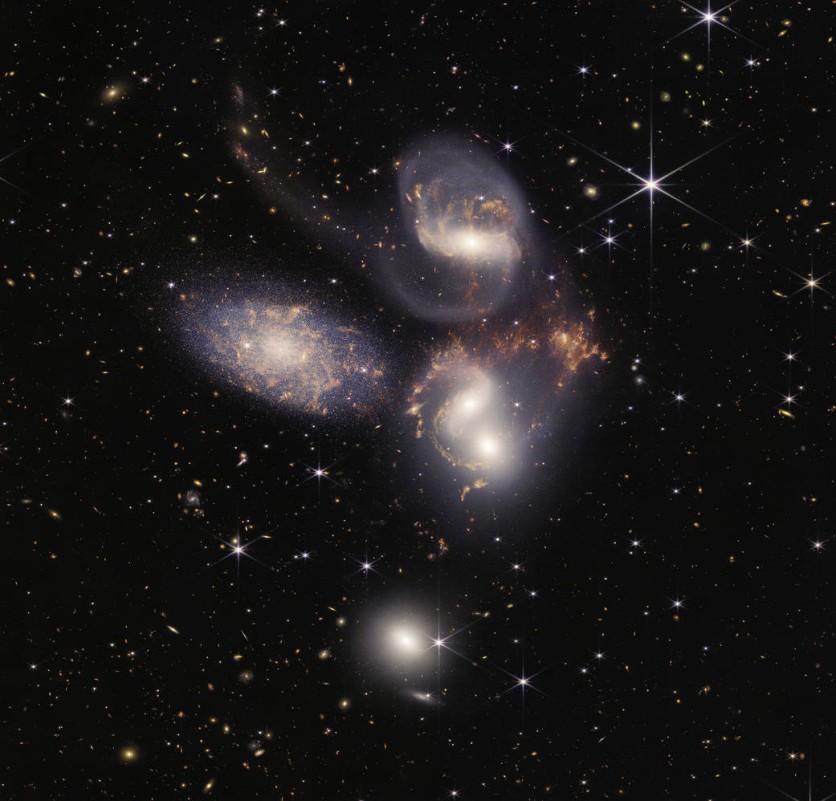NASA's newly-minted telescope has found strange compounds swirling around supermassive black holes.
As reported first by Space.com, the James Webb Space Telescope (JWST) has discovered carbon-containing polycyclic aromatic hydrocarbons (PAHs) in three galaxies that were previously thought to be unable to exist at the centers of these active galaxies.
The findings also imply that the radiation near the supermassive black holes in these galaxies has changed the general characteristics of the PAHs, which may complicate a crucial method used by astronomers to assess star formation and may also have an impact on their role as biological building blocks.

Three Active Galaxies
A team of astronomers under the direction of Ismael García-Bernete, an astrophysicist from Oxford University in the United Kingdom, have examined these three active galaxies captured by JWST's Mid-Infrared Instrument (MIRI).
The three galaxies are NGC 6552, which is located 370 million light-years from Earth in the constellation Draco; NGC 7319, which is one of the famous Stephan's Quintet's five galaxies and is located 311 million light-years away in Pegasus; and NGC 7469, which is also located in Pegasus and is about 200 million light-years away.
PAHs are molecules distinguished by carbon atom rings. These molecules are extremely prevalent across the cosmos, from far-off galaxies to comets in our solar system, according to Space.com.
Due to their abundance, they serve as both useful tracers for star formation and ideal building blocks for life.
PAHS s radiate at infrared wavelengths observable by MIRI when they are irradiated by ultraviolet radiation in starlight, astronomers who use this method to discover PAHs can be certain that there are young stars nearby.
Garca-Bernete wanted to know if the PAH emissions in the active galaxy's dense, ultraviolet-rich core were the same as those in the spiral arms of galaxies, which are more tranquil star-forming areas.
Read Also : A New York Art Exhibit Features NASA's James Webb Images in 3D, VR, Holograms, and More!
Rich in PAHs
In accordance with earlier simulations, all PAH molecules would be vaporized by the intense radiation surrounding the supermassive black hole in the center of an active galaxy. Instead, MIRI found that the central areas of all three analyzed galaxies were rich in PAHs.
Observations, however, revealed that the emission originated from bigger, electrically neutral PAH molecules, proving that radiation had actually wiped off smaller, electrically charged PAHs, as per Space.com.
The team hypothesized that the larger PAH molecules may have survived because they were shielded by thick, engulfing clouds of molecular gas.
The depletion of the smaller electrically charged PAHs is an issue for astronomers who use these compounds to detect star formation because star-forming regions are frequently higher in electrically charged PAHs.
If stars are destroyed in the centers of active galaxies, astronomers are unable to predict where they might form.
The next stage, according to Garca-Bernete, is to evaluate a bigger sample of active galaxies with various characteristics.
"This will enable us to better understand how PAH molecules survive and which are their specific properties in the nuclear region of galaxies. Such knowledge is key to using PAHs as an accurate tool for characterizing the amount of star formation in galaxies, and how galaxies evolve over time," García-Bernete said in a statement.
This article is owned by Tech Times
Written by Joaquin Victor Tacla




![Most Useful Google Chrome Keyboard Shortcuts You Need to Know to Improve Your Browsing Experience [2024]](https://d.techtimes.com/en/full/449047/most-useful-google-chrome-keyboard-shortcuts-you-need-know-improve-your-browsing-experience-2024.jpg?w=184&h=103&f=476d29fd60df70a67f6679f99a2ca6d0)